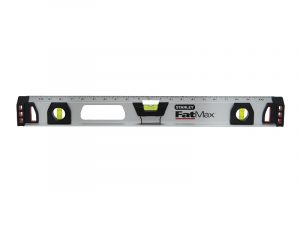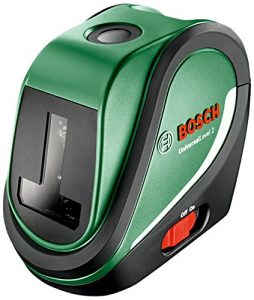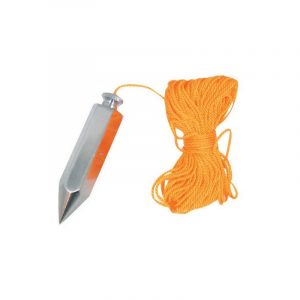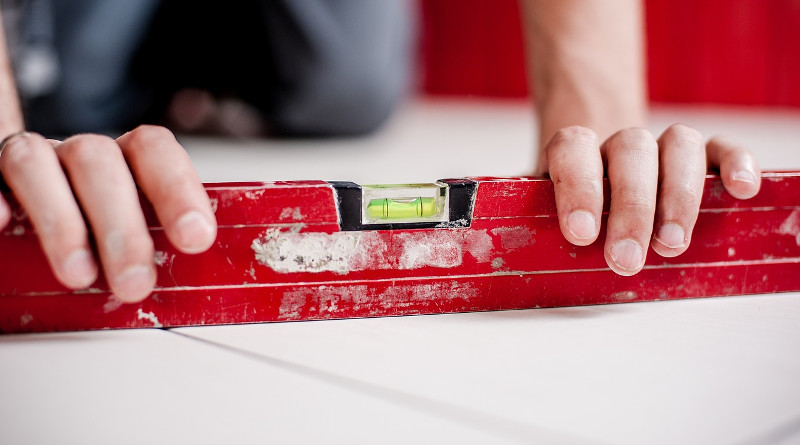Almost any DIY project, from putting up a shelf to building a stud wall, will need you to use a level-finding tool. The most basic of these is a plumb line (for finding vertical alignment) and the trusty spirit level (for finding both horizontal and vertical levels).
Added to these tools is the laser level, a tool that has dropped in price so much over the last few years that anyone can afford to have one in their toolbox.
Having a tool for finding the level of a surface in your toolbox is a must, you just need to decide which is the best tool for your needs.
Spirit Level
 If you do a lot of DIY, you will use a spirit level a lot, so investing in a good-quality level makes sense. You can find spirit levels in a variety of lengths (it is useful to have a mini level and a full length level), made from plastic or metal, and with a variety of features.
If you do a lot of DIY, you will use a spirit level a lot, so investing in a good-quality level makes sense. You can find spirit levels in a variety of lengths (it is useful to have a mini level and a full length level), made from plastic or metal, and with a variety of features.
Possible features include multiple bubbles, a straight-edge ruler, a magnetic strip for working with steel, and even a digital angle display. Some spirit levels have a bubble which can be rotated to display the angle of a slope on an angle gauge. You can even buy spirit levels with a laser marker built-in.
A spirit level will have one or more clear vials (or bubbles) filled with liquid. Each has an air bubble inside it, and marks on the vial to show the centre. When the level is truly horizontal or vertical, the bubble will be perfectly between the two marks.
Laser Level
 Laser levels, once a very expensive tool used only by professional, are now available to buy fairly cheaply. Laser levels fire a laser beam from a base unit that can be made to sit level on a flat surface. The base unit can normally be rotated easily, allowing quick and accurate marking of levels all the way around a room.
Laser levels, once a very expensive tool used only by professional, are now available to buy fairly cheaply. Laser levels fire a laser beam from a base unit that can be made to sit level on a flat surface. The base unit can normally be rotated easily, allowing quick and accurate marking of levels all the way around a room.
Laser levels are useful for a variety of tasks, from marking out the position of shelving in an alcove, to finding the levels for outdoor projects like fencing and paving. They have the benefit of providing a constant mark on a surface, without you having to hold anything (such as a spirit level).
Laser levels range in price from the relatively cheap to very expensive, and will include a range of features depending on the cost. You can buy a kit including a self-levelling laser level, a tripod and protective case for around £30, which should be adequate for most DIY levelling needs.
Features to look for include 360-degree rotation, cross line marker (shows both horizontal and vertical marks), and an adjustable base or tripod.
Plumb Line
 A plumb line, also sometimes called a plumb-bob, is simply a weight attached to a length of string, used to line up things like shelving, or brick or block walls, vertically. Provided the string or weight is not touching anything, the line will always hang perfectly vertical once it stops swinging.
A plumb line, also sometimes called a plumb-bob, is simply a weight attached to a length of string, used to line up things like shelving, or brick or block walls, vertically. Provided the string or weight is not touching anything, the line will always hang perfectly vertical once it stops swinging.
You can buy a plumb line very cheaply, or you can simply make one yourself using a length of string and a heavy nut (or other object) tied to one end. Plumb lines that you buy often have a pointed weight, making it easier to see and mark where the vertical position is.
Plumb lines are only really of use when working inside or on very clam days, as any movement caused by wind will make the line and weight swing. Make sure that the line is firmly attached at the top, to a nail or screw for example, and then use a straight edge held up against the line to transfer the vertical alignment onto a surface behind.







